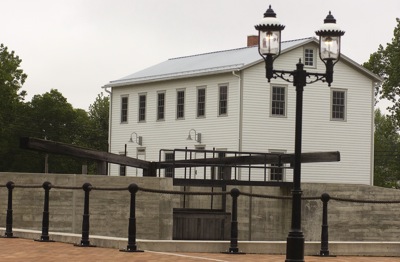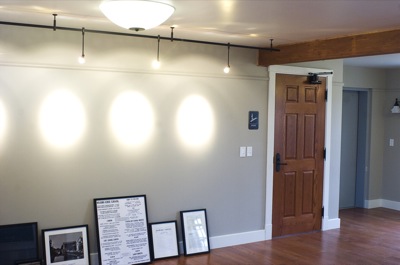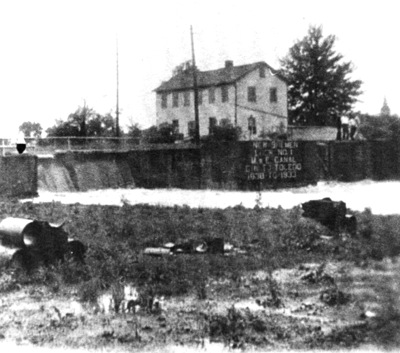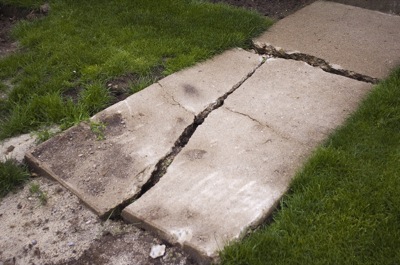Saturday, May 22nd, 2010
New building will house canal's past
By Margie Wuebker

Photo by Mark Pummell/The Daily Standard
The recreated lockkeeper's house stands a stone's throw from Lock One near the intersection of Washington Street (state Route 66) and Monroe Street (state Route 274) in New Bremen. In the original lockkeeper's house, the person in charge of raising and lowering the water levels in the Miami and Erie Canal looked out the top windows at either end to spot approaching boats.
NEW BREMEN - An imposing 21/2-story building once again occupies a place of prominence along the west bank of the Miami and Erie Canal.
Although referred to as the lockkeeper's house, it no longer serves as the residence of the man charged with raising and lowering water levels for passing canal boats.
As a visitor's center, it contains displays harkening back to an era when the canal served as a vital transportation link carrying passengers and freight ranging from locally-produced farm commodities to sturdy wooden barrels from cooper shops in the community.
The Southwestern Auglaize County Chamber of Commerce will occupy the first floor of the 22-by 44-feet building beginning in June. The second floor will be vacant in the wake of a decision by the Miami and Erie Canal Corridor Association (MECCA) not to locate there as previously announced. MECCA Executive Director Neal Brady was not available for comment on the decision.
The handicap-accessible building, equipped with stairways and an elevator, also features a top-floor meeting room with audio-visual resources and a kitchenette. Given the historic displays on the premises, it will be used solely by the chamber, the New Bremen Historic Association and the village.
Historic Association members have nurtured the dream of returning the lockkeeper's house to downtown New Bremen since major renovations several years ago returned Lock One to its 1910 appearance.
"The discovery of the old foundation during reconstruction really spurred interest," association member Delores Stienecker said. "Things really snowballed with Wayne York and other officials getting involved."
The lockkeeper's house project garnered nearly $650,000 in Ohio Department of Transportation enhancement grant dollars with the association pledging $135,000 as the required local match.
Stienecker said every effort was made to reproduce the look and feel of the era with metal roofing, clapboard siding, small-pane windows and a stonework foundation. The old landmark had solid walnut siding, but that material was cost prohibitive.
Local historian Mary Ann Olding said Lock One - the highest point in this part of the state - was one of several hundred constructed along the waterway extending from Toledo to Cincinnati. The original lockkeepers house likely went up shortly after 1839.
Olding continues to research the names of men who tended the lock during the ensuing years. Not much is known prior to the 1870s when Thomas B. Thompson assumed the duties. Walter Thompson succeeded his father in 1907 and worked six years before the devastating flood of 1913 knocked out locks and acqueducts to the point the canal never regained its transportation prominence.
The Thompson house, as locals called it, had 14 rooms - many of which were rented for lodging purposes by passengers and boat crews. A kitchen and wine celler occupied much of the bottom floor with bedrooms and sitting rooms taking the upper floors. Thomas also operated a saloon and grocery there.
The house had no running water. Stienecker remembers local children volunteering to help later owners Herbert and Edna "Gertie" Gross carry water across a wooden bridge from the nearby woolen mills pump.
"Mrs. Gross made the best doughnuts," she said remembering the melt-in-your-mouth confections. "And those doughnuts, or perhaps some of her cinnamon rolls, were our reward. There were always plenty of eager volunteers."
Montezuma resident Rebecca Gross Marley and her sisters also served on the water brigade while living with their grandparents for a time.
Life on the canal proved downright tasty particularly in the summer when the youngsters traveled along the towpath enjoying wild strawberries, raspberries and mulberries. Sometimes they returned with a buckets of freshly picked fruit to be canned or made into pies and jam. Winter brought sledding and ice skating.
"I remember being pinned to the clothesline," Marley added with a chuckle. "Mom warned me to stay in the yard or else. The experience was more fun than punishment."
Her grandparents resided there 20 years before moving to Walnut Street in 1961. The house continued to deteriorate until it became an eyesore.
The house was burned in April 1968 as part of a two-day fire school sponsored by the Central Western Firemen's Association. The event drew 203 firefighters from 33 departments.
Village administrator Wayne York considers the recently completed building the final jewel in the ambitious Lock One reconstruction project which commenced in June 2006.
"This place looks like the original lockkeeper's house," Stienecker said with pride. "However, there will be no boats pulling up out front or people coming to use sleeping rooms for 50 cents a night."
Grand opening set for house:
Grand opening ceremonies at the lockkeeper's house in New Bremen will be 10 a.m. June 19.
The event will feature presentation of colors by the American Legion, music and recognition of donors who helped raise the required matching funds.
There will be several speakers during the 30-minute presentation.
Following the program, people who purchased keys will have an opportunity to officially unlock the door. The winner will receive $1,000, lifetime membership in the New Bremen Historic Association and five historical prints by local artist Pat Wietholter. Unsuccessful key holders will be invited to register for other prizes.
Some of the 1,000 keys remain available for purchase at the Southwestern Auglaize County Chamber of Commerce or by contacting Delores Stienecker at 419-629-2685.
-Margie Wuebker

Submitted Photo
Rebecca Gross Marley of Montezuma has special memories of the former lockkeeper's house. As a 3-year-old who failed to behave, she found herself briefly pinned to the clothesline by her parents.

Photo by Mark Pummell/The Daily Standard
Framed memorabilia from the canal era provided by The New Bremen Historic Association will be hung in lighted display areas inside the house. The 21/2-story building will soon be home to the offices of the Southwest Auglaize County Chamber of Commerce.

Submitted Photo
This is a photo of the original lockkeeper's house in New Bremen.






